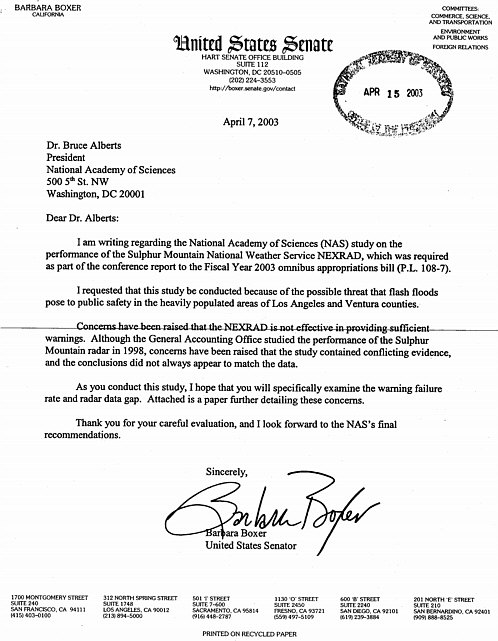Appendix A
Origin of the Study
LANGUAGE FROM THE 2003 CONSOLIDATED APPROPRIATIONS RESOLUTION, PUBLIC LAW 108-7
The conferees direct NOAA to commission the National Academy of Sciences to conduct a study to assess the availability, performance, and capability of the NWS NEXRAD located on Sulphur Mountain in Ventura County, California, to detect heavy precipitation and aid forecasters at the Los Angeles Weather Forecast Office in providing flash flood warnings and forecasts, and on the basis of that study, to provide the Under Secretary of Commerce for Oceans and Atmosphere with a report on the performance of that mission by the NWS. The report also should include any recommendations for improving the accuracy and timeliness of flash flood warnings in and around western Los Angeles and Ventura Counties, California.
ADDITIONAL INFORMATION
-
Since the Sulphur Mountain NEXRAD began operating and its data incorporated into forecasts by meteorologists in the Los Angeles Weather Forecasting Office, it has failed to warn of flash floods nearly 50 percent of the time. Of twelve flood events in the El Niño year of 1998, either no or insufficient warning time was given for five events.
-
According to the administrator of the National Weather Service, the Sulphur Mountain NEXRAD is the only Doppler radar in the Southern California interlocking NEXRAD system whose mission is to detect low-level storms approaching the coast over water in the winter.
-
A geo-spatial chart prepared by the Geo-Spatial Information Center at California State University, Monterey indicates a gap at 6,000 feet between the interlocking NEXRAD radar systems. At 5,000 feet this gap is considerably larger. The gap indicated by the chart has been created by the Sulphur Mountain NEXRAD beam being located too high and the reach of the Santa Ana Mountains’ NEXRAD reach being very limited. The Santa Ana Mountains’ NEXRAD barely extends beyond the coastline at the altitude of 5,000 feet. This gap creates a lack of available data.
-
The preliminary NEXRAD site survey for the Los Angeles area stated that the Sulphur Mountain radar, in order to avoid anomalous propagations, needed to be placed at an elevation of over 2,000 feet. As a result, the Sulphur Mountain NEXRAD was placed at 2,750 feet. The height of inversion, where warmer air meets cooler air in the atmosphere, is 2,000 feet according to the site survey. Even though Sulphur Mountain NEXRAD is relied upon to provide continuous data to forecasters on the possibility of flash floods, the lower altitude of winter inversions was not taken into account in the site survey. In fact, the South Coast Air Quality Management District studied the years from 1950 to 1974, and found that during the month of January the coastal inversion exceeded 100 feet only three times.






